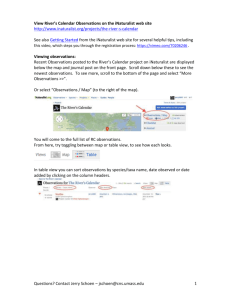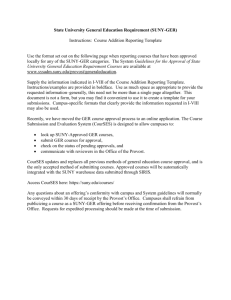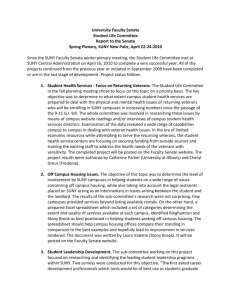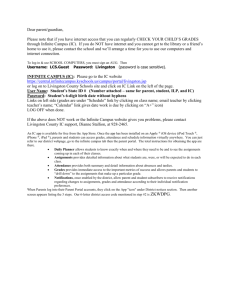Mobile Devices as Tools for Service Learning
advertisement
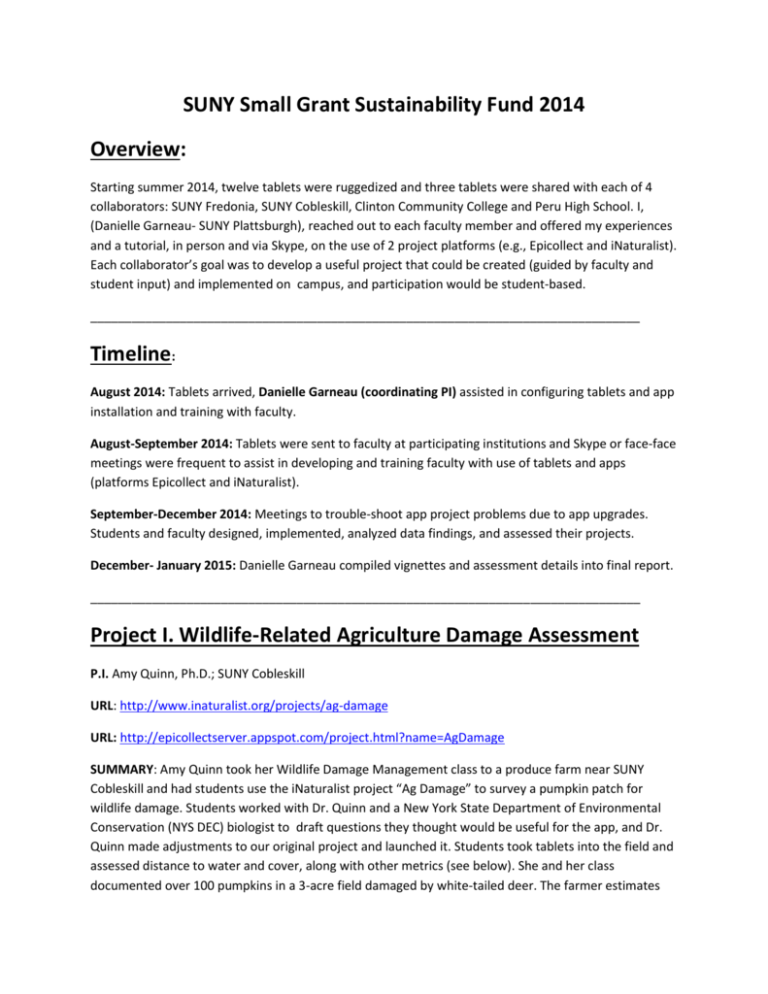
SUNY Small Grant Sustainability Fund 2014 Overview: Starting summer 2014, twelve tablets were ruggedized and three tablets were shared with each of 4 collaborators: SUNY Fredonia, SUNY Cobleskill, Clinton Community College and Peru High School. I, (Danielle Garneau- SUNY Plattsburgh), reached out to each faculty member and offered my experiences and a tutorial, in person and via Skype, on the use of 2 project platforms (e.g., Epicollect and iNaturalist). Each collaborator’s goal was to develop a useful project that could be created (guided by faculty and student input) and implemented on campus, and participation would be student-based. ________________________________________________________________________________ Timeline: August 2014: Tablets arrived, Danielle Garneau (coordinating PI) assisted in configuring tablets and app installation and training with faculty. August-September 2014: Tablets were sent to faculty at participating institutions and Skype or face-face meetings were frequent to assist in developing and training faculty with use of tablets and apps (platforms Epicollect and iNaturalist). September-December 2014: Meetings to trouble-shoot app project problems due to app upgrades. Students and faculty designed, implemented, analyzed data findings, and assessed their projects. December- January 2015: Danielle Garneau compiled vignettes and assessment details into final report. ________________________________________________________________________________ Project I. Wildlife-Related Agriculture Damage Assessment P.I. Amy Quinn, Ph.D.; SUNY Cobleskill URL: http://www.inaturalist.org/projects/ag-damage URL: http://epicollectserver.appspot.com/project.html?name=AgDamage SUMMARY: Amy Quinn took her Wildlife Damage Management class to a produce farm near SUNY Cobleskill and had students use the iNaturalist project “Ag Damage” to survey a pumpkin patch for wildlife damage. Students worked with Dr. Quinn and a New York State Department of Environmental Conservation (NYS DEC) biologist to draft questions they thought would be useful for the app, and Dr. Quinn made adjustments to our original project and launched it. Students took tablets into the field and assessed distance to water and cover, along with other metrics (see below). She and her class documented over 100 pumpkins in a 3-acre field damaged by white-tailed deer. The farmer estimates $1,000 in lost revenue for the fall 2014 pumpkin crop season from this single field. The local farmer and NYS DEC are very interested in a long-term project monitoring damage to pumpkins, corn, and other produce through the growing season to determine if changes to agricultural practices could minimize wildlife-related crop damage. PROS: The NYS DEC is very interested in the Ag Damage project. State agencies are tasked with distributing a variety of permits to manage problem wildlife, and baseline data are needed to evaluate the extent and progression of wildlife damage to agricultural products so that agencies understand whether permit programs are effective. Additionally, long-term monitoring of crop damage by wildlife allows agencies to see if control and mitigation efforts are working to reduce or eliminate problems for stakeholders. Students also found the technology of the Ag Damage app to be appealing and useful for field data collection. They appreciated the ease of recording lengthy GIS coordinates and other data to later evaluate the spatial distribution of crop damage. They also reported that using the app (especially documenting damage via photos) allowed them to become more familiar with the characteristics of damage caused by different species of wildlife. Data were organized well and were easily downloaded and imported into other platforms (i.e., GIS) for further analysis in the classroom. The project had an excellent community outreach component. The local farmer with whom the class worked was very interested in our findings about the spatial distribution of damage in his pumpkin patch. We observed that the majority of damage events occurred along a two-track path regularly driven through the field while harvesting crops. This path created a corridor for deer movement and he intends to reconsider his harvest practices next fall. We were also able to quantify for the farmer his economic losses associated with wildlife damage, and we will be able to track such losses in future years to determine if his wildlife abatement practices are effective. CONS: We had some challenges with wi-fi availability. Wi-fi needed to be configured properly to sync on campus and IT needed to intervene due to restrictions on campus. Despite modifying the order of questions on the iNaturalist website, they appeared in a somewhat random order on the mobile device, so students had to enter data via a non-intuitive process. Additionally, due to the nature of the platform, students had to identify the “species” in the project as the agricultural crop. In reality, we were actually interested in the wildlife species causing damage (i.e., white-tailed deer, raccoon, skunk) but there was no good way to log the wildlife with photos. This created a backflow problem within the wider iNaturalist community, where no “experts” were interested in confirming our observation of “pumpkin” because it is not a wild species. Additionally, new updates to the iNaturalist app made it impossible to see additional questions built into the project. Students commented about the time spent entering the same information multiple times, as the organizational structure of data collection required all of the data about the field in general to be logged for each data point. Students also complained about screen glare while trying to enter data; questions were difficult to see because the data entry fields were built on a black background. Assessment (sub-sampling): Using tablets/apps increased learning experience: Agree 60% Using tablet sensors (GPS, camera) etc. was better than paper entry of data: Absolutely agree 70% Tablet/apps important in documenting wildlife damage: Agree 70% Tablet/apps important tools to create management strategies: Agree 60% Did the campus provide appropriate wi-fi for the project: 30% no, 40% uncertain ______________________________________________________________________________ Project II. Stream Macroinvertebrate Assessment P.I. Richard Hathaway; Peru High School URL: http://www.inaturalist.org/projects/peru-ny-stream-invertebrates URL: http://epicollectserver.appspot.com/project.html?name=PeruNYStreamInvertebrates SUMMARY: For many years Mr. Richard Hathaway has been collecting stream macroinvertebrates in his Regents course. He is a Master Teacher and collaborates with SUNY Plattsburgh faculty for several of his projects implemented at the high school. As a result, I reached out to him thinking he and his class would benefit with the addition of tablets to collect data in his field labs. Peru High School Biology students worked with Mr. Hathway to transition their yearly stream macroinvertebrate assessment onto an online repository using iNaturalist on the tablets. PROS: Excellent organization of data once imported and accessible for classroom analysis. INaturalist linked to other learning materials (Wikipedia sites) detailing organisms. Product is a self-contained website that can be grown in future classes. CONS: Peru High School IT needed to intervene due to restrictions on campus (content filtering such as blocking websites/apps for minors other than iNaturalist). Additionally, there were IT concerns because the device is Android-based and not the platform the school is using (lack of control through IT). Thirdly, new updates to iNaturalist app made it impossible to see additional questions built into the project. It also was difficult to take tablets into the field to collect data in an aquatic environment (cases are water resistant, but not water-tight/LifeProof). The organizational setup of iNaturalist is not optimally suited for a stream study like this, where the input is based on the Orders/species found, and each input has to be accompanied by the rest of the stream data, resulting in arduous data entry. Finally, the project required assistance in macroinvertebrate identification from graduate students and faculty from SUNY Plattsburgh with this expertise (note: this is true in SUNY Plattsburgh macroinvertebrate collegiate-level labs as well). Project will likely need some fine-tuning in 2.0 version. Assessment (sub-sampling): See included PDF of internal assessment questions, but generally the students pre- and post-test had similar responses to questions. What did appear negative were internet services/support for the projects. One highlight from the assessment was this: _____________________________________________________________________________________ Project III. Bird Window Strike Surveys on Campus P.I. Danielle Garneau; SUNY Plattsburgh URL: http://www.inaturalist.org/projects/bird-window-strike-suny-plattsburgh URL: http://www.inaturalist.org/projects/suny-plattsburgh-campus-arboretum-project-phase-1 Summary: SUNY Plattsburgh has participated in the Ecological Research as Education Network (EREN) bird window strike project for 2 semesters. We sought to streamline data collection and eliminate the need to use a binder to collect data. The tablet/app interface would allow long-term data collection, data storage, and data sharing among other colleges in this EREN project to compare data. PROS: There was excellent organization of data once imported and accessible for classroom analysis. INaturalist linked to other learning materials (Wikipedia sites) detailing organisms. This project has the potential to be well organized and easily contribute data to the Ecological Research as Education (EREN) network Bird Window Strike Project: https://sites.google.com/a/augustana.edu/eren-bird-windowcollisions-project/ (P.I.s Stephen Hager and Bradley Cosentino) CONS: No wi-fi signals outside campus buildings where this sort of research is in need. Campus has few bird window strikes (2 consecutive years). Only one interested student was available to pilot this project this semester. She overextended and was unable to complete all needed components on the EREN project, but did do daily surveys for birds during the migration window. Building selection this year did not meet the criteria required to participate in EREN project. New updates to iNaturalist app made it impossible to see additional questions built into the project. This was remedied at the end of the study. Additionally, one important procedure in the EREN bird window collision collaboration is to “test” our students with some decoy birds around buildings as a quality control measure. When these are found and logged into iNaturalist, there is an issue with verification since they are not real species. As a result, these decoys show up in the iNaturalist map project as unverified question marks. Assessment: The one student participant participated in the pre-test survey, but has not followed up on the post-test survey assessment on SurveyMonkey yet.__________________________________________________________________________________ Project IV. Saranac River Trail Trees P.I. Danielle Garneau; SUNY Plattsburgh URL: http://www.inaturalist.org/projects/saranac-river-trail-trees Summary: This project was created to assist in the development of the growing Saranac River Trail through the City and Town of Plattsburgh, NY. The hope is that citizens, walking/biking this trail, will better appreciate and inventory the flora along the route. PROS: There was excellent organization of data once imported and accessible for classroom analysis. INaturalist linked to other learning materials (Wikipedia sites) detailing organisms. This project has the potential to integrate learning from other classes (Forest Ecology and Management, Sustainability) and develop a management plan to share with town planners to enhance carbon sequestration on campus through the use of this website: http://www.itreetools.org/eco/ This project began due to urgency when a colleague was unable to implement their app project in a class due to their uneasiness of working with tablets/apps. I was concerned that no project would be implemented at the host campus location, so I started this project while on maternity leave with my infant in a stroller. It was actually really a nice day spent logging trees along the river trail. The trail is fairly new and runs through our college campus and out into the city and town. There is a committee of citizens and professionals who are working to build innovation into the trail and grow the length of the trail along the Saranac River into other towns. My hope is that we can share this app with the committee and community and have others who use the trail map species. As a wildlife researcher, trees are not my forte. I was grateful that one feature of iNaturalist is that experts chime in with validation suggestions and I had the opportunity to curate the species logged to reflect those updates. This feature is true on all iNaturalist projects, which can prove problematic in projects that are not “bioblitz-like” such as the Ag Damage project in Cobleskill. CONS: There are no wi-fi signals outside campus buildings where this sort of research is in need. New updates to the iNaturalist app made it impossible to see additional questions built into the project. Assessment: No assessment was performed as no students participated, it was just myself. ________________________________________________________________________________ Project V. Bryophyte Survey using Tablets P.I. Jacob Straub, Ph.D.; SUNY Plattsburgh Summary: Field Ecology is a field-based course where students visit various habitats (e.g., forest, wetland, sandstone pavement barren etc.) and explore flora and fauna. We learned of a technique to place a hand lens against your smartphone at a regional conference, and set out to apply for an ed tech grant, through SUNY Plattsburgh, to furnish pro-scope cameras (macro) to each of the 20 tablets we had earlier acquired in a grant. Upon further research, we located the EasyMacro rubber band lens to fit over a smartphone lenses and worked with the company to make a larger band to better accommodate tablet cases. This use of technology unlocked a completely different group of organisms to this class, namely the bryophytes (e.g, mosses, liverworts etc.) On the September 10th 2014 Field Ecology (ENV 337) students (n = 21) visited Altona Flatrock to study and inventory Bryophytes (mosses, liverworts and hornworts). Bryophytes are small non-vascular plants that can serve as important indicators of ecosystem integrity. Given their small stature, students often have difficulty learning basic bryophyte morphology and species identification. While a hand lens can be effective for these objectives some students have difficulty using them. As an alternative to 10X hand lenses students used Google Nexus Tablets with 10 X rubber band magnifiers to zoom in on these organisms. Pros: Tablets have numerous advantages over traditional hand lenses; 1) allow the opportunity to “capture” images with photos and 2) the “built-in” zoom can provide even greater magnification. These added features contribute to enhanced interest and investment among the students. The tablets, magnifiers and their functionality greatly enhanced the Bryophyte experience and this faculty member will be using them every time the lab is taught in the future. Cons: Two drawbacks of these tablets are 1) it was time consuming and cumbersome to download all the photos that were taken and 2) the magnifiers did not quite fit the tablets. It seems EasyMacro did not completely factor in dimensions on rugged cases. Assessment: In this Field Ecology class, course evaluations were completed and students overwhelming loved the bryophyte lab. This experience inspired an independent study research presentation that was presented at the Northeastern Natural History Conference. ____________________________________________________________________________________ Project VI. Campus Tree Inventory at Clinton Community College P.I. Michele Snyder; Clinton Community College URL: http://www.inaturalist.org/projects/ccctrees SUMMARY: This project was designed to inventory tree species about the Clinton Community College campus and engage students and campus planners in landscape choices as construction of new facilities is about to occur. PROS: There was excellent organization of data once imported and accessible for classroom analysis. INaturalist linked to other learning materials (Wikipedia sites) detailing organisms. This project has the potential to integrate learning from other classes and develop a management plan to share with buildings and grounds to enhance carbon sequestration on campus through the use of this website: http://www.itreetools.org/eco/ CONS: There was limited wi-fi signal outside campus buildings where this sort of research is needed. New updates to the iNaturalist app make it impossible to see additional questions built into the project. There was less interest among colleagues in embedding this technology in classes, thus there may be concern for long-term sustainability of this project. The main P.I. is no longer teaching at the college and has taken on an administrative role. This project in particular struggled with technical issues in implementation and likely was not very active among students because of the loss of the faculty member. Students using the tablets/app were in a Biology club and had little knowledge of tree species, which resulted in odd species ID and later, follow-up experts questioning findings. Assessment: No assessment was performed, even though I created a pre-test and post-test on SurveyMonkey and shared the link with the P.I. on CCC’s campus. Additionally, this P.I. had planned to create the overall assessment of the cross-campus learning outcomes and did not complete this, likely due to her change in role on the campus from teaching to administration. I followed up on countless occasions via email, phone, and in person. ____________________________________________________________________________________ Project VII. TrashTracker Inventory of Campus Litter Habits P.I. Sherri Mason; SUNY Fredonia URL: http://epicollectserver.appspot.com/project.html?name=TrashTracker URL: http://www.inaturalist.org/projects/trash-tracker SUMMARY: I (Danielle Garneau), developed this TrashTracker app with my students in a Population and Community Ecology class at SUNY Plattsburgh. It was an app that was offered as a project for any participating P.I. and Dr. Sherri Mason (SUNY Fredonia) thought this would be a useful endeavor. Dr. Sherri Mason is the Sustainability and Environmental Science Coordinator at SUNY Fredonia. She mirrored what I had my students do, which was partition project jobs into small groups and later present the findings. PROS: This is a great project to encourage service learning and a nice way to hone skill sets from different students (e.g., GIS group, data analysis group, assessment group, PR group etc.). It is also an excellent way to connect students, faculty, and campus buildings/grounds to get a dialogue started regarding smart planning of waste management. CONS: I experienced some glitchiness with the Epicollect app. Some students were not committed, as this was an optional assignment in a biochemistry class for students who performed poorly on the first exam. Assessment (sub-sampling) (removed 1 student whose responses were outliers b/c he did not participate): Do you feel using tablets/smartphones increased data collection efficiency and storage/accessibility for later analysis?: 100% Agree Do you feel using the tablets/smartphones increased your confidence in performing ecological research?: 70% Absolutely Agree Do you feel using tablets in the field/classroom increased your confidence with technology for use in scientific research? 90% Absolutely agree Do you feel using the tablets in the field increased your ability to think of your research questions across scales (local, regional, global)? 60% Absolutely agree, 40% Agree Do you feel using tablets in the field/classroom enhanced your learning experience? 70% Absolutely agree, 30% Agree Do you think using the tablet's sensors (GPS, camera, etc.) was a more positive experience than paper entry and the need for other equipment (GPS, camera, compass)? 100% agree Do you feel the use of the tablet and associated app made it easier to quantify litter pollution in the field? 100% Absolutely agree Would you say Trash Tracker is effective in making the yourself/ your community more environmentally aware? 70% Absolutely agree, 30% Agree Are there improvements that could be made to Trash Tracker? Lack of Participation (20%) Issues with Outreach (20%) Time Constraints (10%) Technical/software difficulties (0) Issues with Form (30%) After participating in Trash Tracker, would you say you notice more litter on the ground than before? 80% Absolutely agree Summary Overall Grant: I felt this was a valuable collaboration, albeit participation and project outcomes varied in scope at all institutions. In particular, I felt that the Ag Damage project will continue and has the support of the NYS DEC which might lead to changes in wildlife management. Additionally, TrashTracker was better received on SUNY Fredonia campus and had low-no issues with the Epicollect app, different from what we struggled with on SUNY Plattsburgh’s campus. Finally, Peru High School took on an ambitious project given the difficulty in identifying stream macroinvertebrates. The project success stems directly from the commitment and drive of the P.I. Mr. Hathaway at the Peru High School. In terms of collaboration, as with all projects it depends on the level of commitment of participants. We had no control over the change in career of the CCC participant that made this project implementation and grant assessment successful. Generally issues that should be noted if projects like these are supported by SUNY Central: 1) There must be better wi-fi access on our campuses. The learning does not stop outside classroom walls. At SUNY Plattsburgh, Rugar Woods is our campus’s field lab and having wi-fi access in the adjacent woods and campus would grow the sustainable learning experiences for our students. This might be remedied by turning faculty mobile devices into mobile hotspots that would extend the range of internet services when students were in the field. 2) As technology and programming is constantly changing, it was difficult to rely on the 2 apps (Epicollect, iNaturalist) that are user-friendly in modification. Epicollect gathers location and photo data, and allows users to determine questions, but the creators are slow to address changes in the app as new smartphones and tablets roll out. As a result, in certain regions the app is glitchy and shuts down sporadically or does not open on some smartphones. I have built several projects using this app (RoadkillGarneau, WildlifeBlitzGarneau, WildlifeTrackingGarneau, TrashTracker, etc.) and the success depends on the ability for the app to work on all users’ mobile sensors. The issue with iNaturalist, a stronger app that links to excellent learning materials on species and allows for expert verification of species is that SPECIES is the first question that must be input. If the project involves collecting trash or inventorying crop species for wildlife damage, then it is impossible to have experts determine “species” of trash or pumpkin. In particular the crop issue is that we are really targeting the wildlife species doing the damage on the pumpkin and there are no experts available to verify those species. These issues might be alleviated by having our P.I. Dr. Amy Quinn create a photo key of typical wildlife damage by common species on various crop plants that could be made available on her website. iNaturalist is a recommended app because it is so stable, has added special features, but also has excellent user support. The drawback is our additional built in questions were not visible during one of their app upgrades which happened to fall in the middle of project implementation. We were able to communicate with iNat help and get a work-around, but student and faculty frustrations were high and there is no telling when upgrades might impact future projects. 4) It would be ideal for SUNY Central to encourage Computer Science faculty and staff, or local community programmers to work with other faculty on campus in brainstorming, coding, implementing, and verifying relevant apps for projects on campuses. I see this as an excellent use of in-house resources and would foster collaborations among departments and with the community. 3) In order for these projects to have reach, they should have better PR in SUNY Central. We should create a HUB of working projects and a network of faculty performing these citizen science endeavors. Something similar to what Macalaster has done with MACADEMIA would be terrific. http://macademia.macalester.edu/Macademia/ 5) Finally, financial support for faculty working on these endeavors, as well as travel support to conferences and other SUNY schools to share their work would be beneficial.

